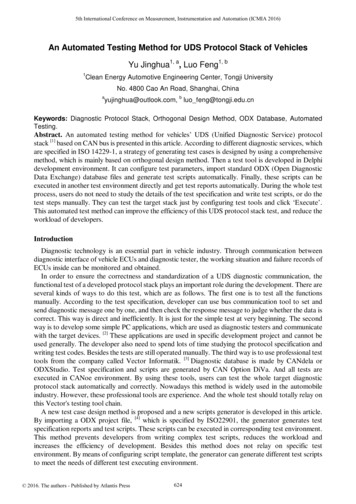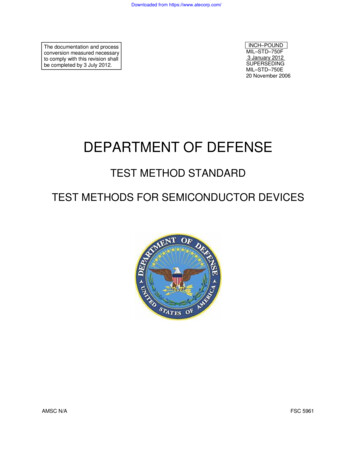
Transcription
5th International Conference on Measurement, Instrumentation and Automation (ICMIA 2016)An Automated Testing Method for UDS Protocol Stack of VehiclesYu Jinghua1, a, Luo Feng1, b1Clean Energy Automotive Engineering Center, Tongji UniversityNo. 4800 Cao An Road, Shanghai, Chinaayujinghua@outlook.com, b luo feng@tongji.edu.cnKeywords: Diagnostic Protocol Stack, Orthogonal Design Method, ODX Database, AutomatedTesting.Abstract. An automated testing method for vehicles’ UDS (Unified Diagnostic Service) protocolstack [1] based on CAN bus is presented in this article. According to different diagnostic services, whichare specified in ISO 14229-1, a strategy of generating test cases is designed by using a comprehensivemethod, which is mainly based on orthogonal design method. Then a test tool is developed in Delphidevelopment environment. It can configure test parameters, import standard ODX (Open DiagnosticData Exchange) database files and generate test scripts automatically. Finally, these scripts can beexecuted in another test environment directly and get test reports automatically. During the whole testprocess, users do not need to study the details of the test specification and write test scripts, or do thetest steps manually. They can test the target stack just by configuring test tools and click ‘Execute’.This automated test method can improve the efficiency of this UDS protocol stack test, and reduce theworkload of developers.IntroductionDiagnostic technology is an essential part in vehicle industry. Through communication betweendiagnostic interface of vehicle ECUs and diagnostic tester, the working situation and failure records ofECUs inside can be monitored and obtained.In order to ensure the correctness and standardization of a UDS diagnostic communication, thefunctional test of a developed protocol stack plays an important role during the development. There areseveral kinds of ways to do this test, which are as follows. The first one is to test all the functionsmanually. According to the test specification, developer can use bus communication tool to set andsend diagnostic message one by one, and then check the response message to judge whether the data iscorrect. This way is direct and inefficiently. It is just for the simple test at very beginning. The secondway is to develop some simple PC applications, which are used as diagnostic testers and communicatewith the target devices. [2] These applications are used in specific development project and cannot beused generally. The developer also need to spend lots of time studying the protocol specification andwriting test codes. Besides the tests are still operated manually. The third way is to use professional testtools from the company called Vector Informatik. [3] Diagnostic database is made by CANdela orODXStudio. Test specification and scripts are generated by CAN Option DiVa. And all tests areexecuted in CANoe environment. By using these tools, users can test the whole target diagnosticprotocol stack automatically and correctly. Nowadays this method is widely used in the automobileindustry. However, these professional tools are experience. And the whole test should totally relay onthis Vector's testing tool chain.A new test case design method is proposed and a new scripts generator is developed in this article.By importing a ODX project file, [4] which is specified by ISO22901, the generator generates testspecification reports and test scripts. These scripts can be executed in corresponding test environment.This method prevents developers from writing complex test scripts, reduces the workload andincreases the efficiency of development. Besides this method does not relay on specific testenvironment. By means of configuring script template, the generator can generate different test scriptsto meet the needs of different test executing environment. 2016. The authors - Published by Atlantis Press624
System OverviewFig.1 shows the system structure, including script generator part and test environment part.Test EnvironmentScript GeneratorSoftWareHardwareDatabase ResolverUser ConfigurationTest EngineAutoCANReport GeneratorDUT withTarget StackFig. 1 System StructureThe function of the generator is to generate the test specification reports and scripts according tothe imported ODX files and users' configuration. The database file resolver and user configurationmodule gather information from imported ODX files and user configuration interfaces respectively.Both kinds of information are transmitted into the core generating module. And finally the generatorgenerates specifications and scripts.The function of the test environment is to execute test scripts. Software environment can run thescripts, control the hardware tool to stimulate communication on real CAN bus, record test steps anddata flows in details and finally generate test reports. Hardware environment is a real communicationnetwork. AutoCAN is a CAN bus design tool from the company called ihr. It is controlled by PC andstimulate or monitor the behaviors on the CAN bus. DUT represents device under test.Design of Test MethodTest Object. UDS protocol stack is the main test object, which is installed in a network node inside avehicle and responsible for the diagnostic communication process. The structure of a protocol stackbase on CAN bus is shown below.Application LayerISO14229-1/3Session LayerISO14229-2Network ig. 2 Structure of Target Protocol StackThe non-application layers ensure that the application data can be transmitted correctly to the upperlayer. The application layer is responsible for processing the request and give the response according toISO14220-1. The purpose of the test is to verify whether this diagnostic stack can process the requestcorrectly and give corresponding response.Test Inputs. The input of this test system is a specification file of the target stack, which records all thesupported services and their attributes. ODX file is used as the input file, which is a standard formataccording to ISO22901. This standard format makes sure that there is only one source of thediagnostic data during the whole life cycle of a ECU. It simplifies the data communication amongvehicle factories, OEMs, tool suppliers and after sale servicers and increases the efficiency. [5]ODX file is stored in XML format. Different types of data have different extended file names. Forexample, the file with ‘odx-e’ extended name stores the information about ECU configuration. The‘odx-c’ and ‘odx-cs’ files are related with communication parameters. Information about diagnosticservices is stored in file called ‘odx-d’.625
Test Case Design. The orthogonal design method along with other assistant method are used to designeach test case.By using scenario method, test cases are classified into different classes according to its service. Forexample, ‘Diagnostic Control Service’ and ‘Security Access Service’ are two different kinds of testclasses.By using equivalence class classifying method, a test value can be selected to represent a set ofvalues, which will get the same result. This step can reduce the number of test cases significantly.By using orthogonal design method, all test cases can be designed clearly and orderly. Firstly, thefactor number and factor values should be decided. The table below shows the factor information of‘Diagnostic control service’ test class.Table 1 Factors of 'Diagnostic Control Service' Test ClassTypeSubsuppressPosError Situationfunction RspMsgBit0x010Sub-function invalid (NRC 0x12, sub-function ID 0xaa)0x021Sub-function invalid (NRC 0x12, sub-function ID 0xcc)OKError0x03Data too long(NRC 0x13, invalid data 0x11)Data too long (NRC 0x13, invalid data 0x22)No sub- function(NRC 0x13)Then all the factors above can be arranged and combined with each other in an orthogonal table.Finally, a test case table is formed. The following is an example table, which shows parts of the testcases in ‘Diagnostic control service’ test class. Each row in this table describes a test case in details.Table 2 Examples of the Orthogonal Table (Diagnostic Control rror 20x020x030000NRC 0x13 long 0x22NRC 0x13 long 0x11Test Script GeneratorWorkflow of Script Generator. Test scripts are generated by a self-developed generator. Theworkflow is as follows.1) Import an ODX project file;2) Extract useful data and store them into internal memory of the generator;3) Get users’ configuration from user interface;4) Form test case content according to the imported data, users’ configuration and built-in testcase generation strategy;5) Print test specification report and export PDF file by using FastReport tool;6) Fill in test script template and generate scripts for each test case.Parameter Configuration. Test parameters can be configured though user interface, which is shownbelow.626
Fig. 3 Generator User InterfaceDifferent kinds of parameters can be found in corresponding tab.'Communication Configuration' tab is related to communication parameters, such as minimumrequest distance, timeout time and so on.'Diagnostic Services Configuration' tab includes a list, which lists all services supported by this targetstack. User can select the target test services in this test round.'Diagnostic Trouble Code' tab includes configuration about DTC and related test parameters.'Test Specification' tab is used to show the current generated test content.Generator Outputs. There are three parts of the outputs.The first one is the content of the generated test cases this time, including case indexes and syntheticnames. This content is used to configure test environment.The second one is a test specification report, which is a reference for the user. Fig.4 is an example ofthis specification, which describes the test request and expected response in details.Fig. 4 Example of Test SpecificationThe third one is test scripts, which can be executed directly in target environment.Test ImplementEstablish the test environment. The first step of a test is to build a test environment. The followingfigure shows the structure of the hardware environment.Fig. 5 Structure of Hardware EnvironmentThe target stack is download into a DUT. which is connected with AutoCAN though a CAN businterface board. AutoCAN is connected with PC and stimulates bus behaviors according to thecommands from PC.The test software is ihr Test System. There is a test case list on the left side, which can be configuredflexibly. The right part can show test logs and summary. By double-clicking a term in the case list, ascript editor pops up, in which test scripts can be edited. In this article, test scripts are generated by thegenerator automatically.Test Steps. The standard test steps are listed as follows.1) Get ODX project files of the target stack and import them into the generator;627
2) Configure test parameters and select target test services;3) Use generator to generate test case content, specification report and scripts;4) Import test content into the test system environment and configure it;5) Select target cases, compile and execute test scripts;6) Finish the test and get the test report automatically.Test Verification. In order to verify the test method described in this article. A standard DUT is usedas a standard device. Finally, the test results are compared with the standard test results. By thiscomparison, the new method can be verified.The verification process is divided into two steps. The first step is called OK test. In this kind of tests,all the data in ODX file is matched with the target DUT. The second step is called error test. Some datais changed in the data base to make error test result on purpose. This step can verify whether the systemcan find the errors.38 test cases are used to do the system verification, including two common service classes. In thefirst step, all cases are passed as expected. In the second step, the key value of the security accessservice is changed, which results failure in two relevant test cases. The statistic figures of these two testrounds are shown below.Fig. 6 Statistic Figure (Left: OK Test, Right: Error Test)A test report is generated automatically after each test step finishes. In the report, test steps and dataflow on the CAN bus are recorded in details. If these is any failure during the test, the error step ishighlighted by red. This is helpful for the developer to locate errors. Fig.8 is an example of a failed testreport.Though the tests above, the functions of this test method is verified.Fig. 7 An Example of Failed Test ReportConclusionsThis article mainly describes an automated test method for UDS protocol stack of vehicles. A casegenerating strategy is designed according to international standards and a test scripts generator isdeveloped. It can import target database files and generate test specification and scripts. These scriptsare executed in ihr test system and control the bus behaviors thought a CAN bus tool. When all teststeps finish, a report is generated automatically. This method can improve the development efficiencyof UDS protocol stack and reduce the workload of developers.References[1] ISO14229-1. Road vehicle - Unified diagnostic services (UDS) - Specification andrequirements[S]. 2013.[2] Han Xin, Bao KeJin, Development and test of CAN bus network layer protocol stack[J], ComputerEngineering, 2011, 15: 232 - 234 237.628
[3] Peti, Philipp, et al. A quantitative study on automatic validation of the diagnostic services ofElectronic Control Units. Emerging Technologies and Factory Automation, 2008. ETFA 2008. IEEEInternational Conference on. IEEE, 2008.[4] ISO22901-1. Road vehicles - Open diagnostics data exchange (ODX) - Part 1: Data modelspecification[S]. 2008[5] Chen Yupeng, Ge Liang et al. Research and application of ODX based on UDS diagnosticprotocol[C]. Annual Conference of Society of Automotive Engineers of China, 2014:4.629
stimulate or monitor the behaviors on the CAN bus. DUT represents device under test. Design of Test Method Test Object. UDS protocol stack is the main test object, which is installed in a network node inside a vehicle and responsible for the diagnostic communication process. The structure of a protocol stack base on CAN bus is shown below.











